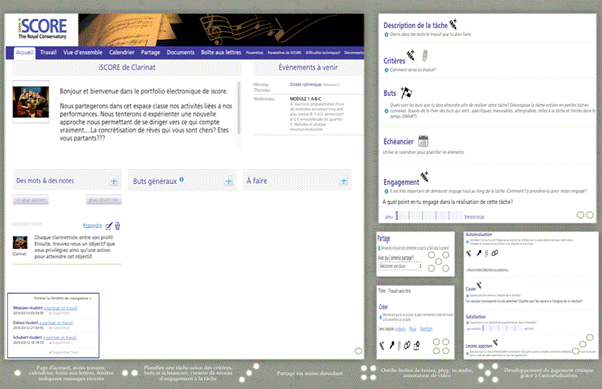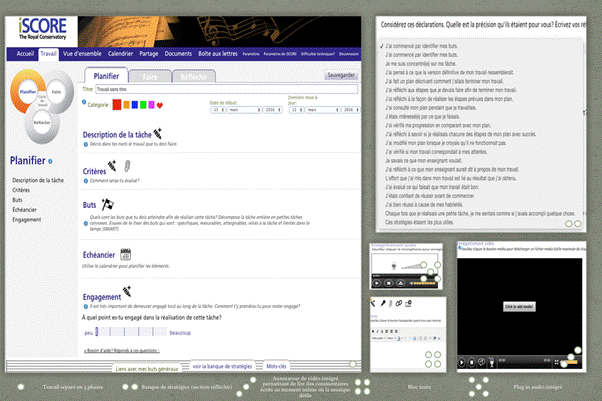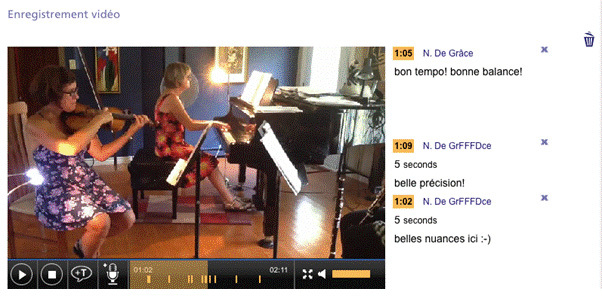iSCORE: An ePortfolio in Music for the Benefit of Students!
I integrated the use of an ePorfolio into my clarinet and chamber music classes, into my instrument labs as well as ear training. I have happily found that this new practice has greatly improved my approach to teaching and has allowed me to implement self-training for students.
Using My Experience to Help the Students
I’m what some would refer to as an “extensive educational traveller” who has always been steeped in music! After graduating from McGill University, then the University of Moncton, I had the opportunity to teach music at the Carrefour, a French secondary school in Dartmouth, Nova Scotia. I then rounded out my training at the University of Calgary, only to return once again to Moncton – this time as a university professor.
I finally returned to Quebec in the year 2000, with an enhanced resumé. However, once I had returned I had a new challenge to tackle: to adapt to the famous Reform that was being implemented in the province at the time. Not so easy when you have been ‘abroad’ for a number of years and you come home thinking that little or nothing will have changed…
Perhaps I wasn’t adequately prepared for my return to Quebec, but I wasn’t too worried about it. My goal was to adapt, taking an active part in this wind of change brought about by the Reform. I looked to do the best I could.
From this time on, I became more and more interested in new technologies and the possibilities they offered to education. I called on this experience when confronted with my new CEGEP students. I also noticed that moving from secondary school to college was an important test for them too. And oftentimes, they weren’t adequately prepared when they arrived at their new CEGEP.
Equip Students to Help Them to Learn Independently
My main objective was to help students to improve the organization of their learning tasks. At the time, I was looking to help them to:
- Find tools to increase their rigorousness when practising music
- Target their organizational needs
- Collaborate among themselves
- Increase their level of commitment to their projects
Ultimately my educational goal was to help them to discover the power they have over their own learning.

An example of the way practising an instrument can be combined with the use of an ePortfolio.
iSCORE: An ePortfolio that Promotes Student Self-sufficiency
After trying many different technological tools (ex: video conferencing, Moodle, distance education courses, local projects…), I began looking for a tool that would allow me to achieve a new primary objective that I had created for myself – to learn how to help students to work more autonomously. For this reason I modified my educational approach, opting to use new technological tools that would allow me to develop this competency. I ended up choosing ePortfolios because of the numerous benefits they provide. Ok, but which one? For a number of reasons, I decided on using iSCORE, a very practical ePortfolio which allows for the integration of the main extension modules that are widely used in music and which were developed BY music teachers FOR music teachers.
iSCORE was designed and developed by Concordia University’s Center for the Study of Learning and Performance (CSLP) in collaboration with Queen’s University’s Royal Conservatory. It`s a web-based communication and practice tool. It was designed to help teachers to motivate their students to take responsibility for their practicing and their learning of music in its entirety.
iSCORE allows students:
- To establish realistic and accessible objectives;
- To gather new artistic works;
- To edit and share their assignments;
- To reply to comments from parents, teachers and peers;
- To facilitate the communication between teachers and their students; and
- To promote the autonomy of learners.

The iSCORE homepage.
Motivate them… From the Inside!
iSCORE is built around 3 steps. These allow for the efficient development of student self-regulation and promote intrinsic motivation.
- Planning paves the way for the action. It is a reflective process about what the student wishes to achieve and how they plan to get there.
- Doing, which is the process that takes place when students are engaged in the actual execution.
- Reflection, which comes after the exercise has been completed and which influences the student’s perception of this performance.

The Planning tab of the iSCORE software.
After a year of experimenting with the software as part of individual music lessons, we chose to try it in the course Formation auditive IV (Ear Training IV) and had to completely rethink our way of teaching in order to implement a new educational approach that relies on the use of the iSCORE software. The functionality of the tool allowed us to completely redesign the course while opting for the deployment of a differential pedagogy based on self-correction as well as building progressive self-regulation of the learning thanks to the integrated video annotation tools, among other things.

Feedback on a video recording of a music practice.
As the screen capture above demonstrates, the user can comment on their own assets (either by pressing the +T icon for written annotations or else clicking on the MICRO icon for spoken annotations). In addition, many commentators can annotate the same video clips. The annotations can be shared from a distance, even beyond class time. This virtual critical judgment can provide new insight to the teacher with regards to their students’ degree of competency development.
Time for the Initial Report
For the initial project report, having used the tool for 6 semesters, I can tell you that the experiment has had extremely positive outcomes, most notably with regards to the meta-cognitive capacity that the students are developing! I am in the process of writing a detailed report to share my experience. It will be available at some point in the winter 2017 semester.
Below I am presenting some of my primary conclusions in terms of the benefits and limitations to the use of the iSCORE software:
The Pros
- A network of students can truly study at their own pace.
- Students are made aware of the important role that they need to play so that they can gradually become self-sufficient in their learning.
- The software also allows for peer assessment (an educational approach that is already in use by another teacher from the college network as reported in a Real Life Story on Profweb).
- The students appreciate the user-friendliness of the tool, since it is available from anywhere (cloud-based).
- Registration is totally free.
- The software is bilingual.
- This tool is accessible as much to students as it is to teachers.
- While it was designed for musicians, the tool has plenty of potential for other applications in colleges, especially for foreign languages, in any disciplines that have placement terms as well as those courses that require autonomous documentation for large projects, like the integrative seminar.
The Cons
- Since you need to get acquainted with a new environment, this educational strategy demands a lot of up-front preparation (as much for teachers as for students).
- This approach is very dependent on technology (and requires a stable high-quality connection to the Internet).
- This approach substantially alters the student-teacher dynamic. Be ready for it!
Sharing a Bit of Advice
Each time you try to integrate new technological tools into the classroom, it’s very important to take a step-by-step approach, and to stay receptive to what students have to say. Here are some of my final pointers:
- Start slowly with your students by targeting a maximum of one or two tasks.
- Try to have small groups of users in the beginning.
- Regularly ask your students about their opinion, using questionnaires for example.
- Include small video clips in the portfolio to show how you do the required tasks using the technology that you have made available to them.
- Quickly respond to any obstacles by providing tailored techno-pedagogical support on a regular basis, most particularly when you first start using the technology.
- Periodically assess their level of skill with the technology.
- Explain to the students the role that they will be playing in this new educational approach while also empowering them to co-manage the learning of the others (this is often sufficient to motivate them (so that they jump head first into the project with you).
- Don’t be shy about getting help from an Education Advisor (Pedagogical Counsellor) at your college! They’ll be happy to help you out.
Are you already working with this software? Please share your experience with us in the Comments area below.

